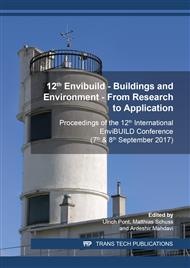[1]
EPBD, Energy Performance of Buildings Directive 2002/91/EC of the European Parliament and of the Council of 16 December 2002 on the energy performance of buildings, Directive 2002/91/EC, Belgium: Official European Union Journal.
DOI: 10.1017/cbo9780511610851.032
Google Scholar
[2]
EPBD, Energy Performance of Buildings Directive 2010/31/EU of the European Parliament and of the Council of 19 Mai 2010 on the energy performance of buildings - recast, Directive 2010/31/EU, Belgium: Official European Union Journal.
DOI: 10.1017/cbo9780511664885.046
Google Scholar
[3]
OIB Guideline 6 – Energieeinsparung und Wärmeschutz, 03/2015. Österreichisches Institut für Bautechnik OIB – available via www.oib.or.at (last accessed June 2017).
Google Scholar
[4]
Austrian Standardization Institute (ASI) – ÖNORM B 8110-standard series (parts 1-7): Thermal insulation in building construction.
Google Scholar
[5]
B. Sommer, U. Pont. Entwicklung einer strukturierten und fehlerminimierten Datenaufbereitung und Dokumentation für Energieausweise (EDEN). Berichte aus Energie- und Umweltforschung 24/2017. Available online via: https://nachhaltigwirtschaften.at/resources/sdz_pdf/berichte/endbericht_2017-24_eden.pdf.
Google Scholar
[6]
U. Pont, O. Proskurnina, M. Taheri, A. Mahdavi, B. Sommer, M. Sommer-Nawara, and G. Adam. Acquisition and processing of input data for building certification: An approach to increase the reproducability of energy certificates; in: Proceedings of the 11th European Conference on Product and Process Modelling,, S.E. Christodoulou, R.J. Scherer (Ed.); Balkema, (2016), ISBN: 9781138032804; S. 243 - 250.
DOI: 10.4028/www.scientific.net/amm.887.212
Google Scholar
[7]
B. Sommer, U. Pont, G. Adam, K. Bollinger, A. Kropf, A. Mahdavi, O. Proskurnina, M. Sommer-Nawara, and M. Taheri; Der Einfluss von Default-Werten auf die Ergebnisse von Bestandsenergieausweisen; invited Lecture at 10 Jahre Energieausweis - Rückblick, Ausblick, Erfahrungen aus der Praxis, Wie geht es weiter?, St. Pölten, Lower Austria 14.04.(2016).
DOI: 10.1007/978-3-8348-2181-2_12
Google Scholar
[8]
QualiCheck-Plattform. http://qualicheck-platform.eu/ (last checked: Aug 2017).
Google Scholar
[9]
E. Panzhauser. Wärmeschutz im Wohnbau, Wien (1979).
Google Scholar
[10]
A. Mahdavi and B. Gurtekin. Shapes, Numbers, Perception: Aspects and Dimensions of the Design-Performance Space. 2002. in: Design and Decision Support Systems in Architecture,, (2002), ISBN: 90-6814-141-4; pp.291-300.
Google Scholar
[11]
W. Pessenlehner and A. Mahdavi. Building morphology, transparence, and energy performance. in: Building Simulation,, (2003), ISBN: 90-386-1566-3 pp.1025-1032.
Google Scholar
[12]
M. Marković. The potential of descriptive building quality specifications as an alternative to the detailed calculation. Masterthesis, TU Wien, Vienna, Austria, supervised by A. Mahdavi and U. Pont.
Google Scholar
[13]
M. Marković, U. Pont, A. Mahdavi The potential of descriptive building quality specifications as an alternative to the detailed calculation. Talk at enviBuild 2017, Vienna, Austria, 07. And 08.September (2017).
Google Scholar
[14]
M. Alhayek. Prescriptive Indicators for usage in Palestine – Approaches to cooling demand (Working title). Master thesis to be finished, TU Wien, Vienna, Austria, supervised by A. Mahdavi and U. Pont (2018).
Google Scholar
[15]
A. Wadi. Prescriptive Indicators for usage in Palestine – Approaches to heating demand and overheating tendencies (Working title). Master thesis to be finished, TU Wien, Vienna, Austria, supervised by A. Mahdavi and U. Pont (2018).
Google Scholar
[16]
U. Pont, N. Ghiassi, S. Fenz, J. Heurix, and A. Mahdavi, SEMERGY: Application of Semantic Web Technologies in Performance-Guided Building Design Optimization; www.itcon.org - Journal of Information Technology in Construction, 20 (2015), Special Issue; pp.107-120.
DOI: 10.1201/b17396-38
Google Scholar
[17]
SEMERGY – available via www.semergy.net (last accessed Aug 2017).
Google Scholar
[18]
S. Glawischnig. An urban monitoring system for large-scale building energy assessment; Dissertation; Evaluated by A. Mahdavi, S. Dustdar; TU Wien, Institute for Architectural Sciences, Dept. Building Physics and Building Ecology 2016; Rigorosum: 18.03.(2016).
Google Scholar
[19]
N. Ghiassi. An Hourglass Approach to Urban Energy Computing. Dissertation; Evaluators: A. Mahdavi, H. Rechberger, D. Saelens, J. Page, S. Dustdar; TU Wien, Institute for Architectural Sciences, Dept. Building Physics and Building Ecology 2016; Rigorosum: 15.12.(2017).
Google Scholar
[20]
U. Pont, D. Latzer, R. Giffinger, and A. Mahdavi. Assessing Energy profiles of urban neighborhoods: A streamlined GIS-based approach. Talk at enviBuild 2017, Vienna, Austria, 07. And 08.September (2017).
DOI: 10.4028/www.scientific.net/amm.887.264
Google Scholar
[21]
C. Spearman. The proof and measurement of association between two things. American Journal of Psychology. 15: 72–101. 1904.
DOI: 10.2307/1412159
Google Scholar
[22]
W.W. Daniel. Spearman rank correlation coefficient, in Applied Nonparametric Statistics (2nd ed.). Boston: PWS-Kent. p.358–365. ISBN 0-534-91976-6.
Google Scholar
[23]
Laerd statistics https://statistics.laerd.com/statistical-guides/spearmans-rank-order-correlation-statistical-guide.php (last accessed in Aug 2017).
Google Scholar
[24]
Leitfaden zur OIB Guideline 6 – Energieeinsparung und Wärmeschutz, 03/2015. Österreichisches Institut für Bautechnik OIB – available via www.oib.or.at (last accessed June 2017).
Google Scholar


